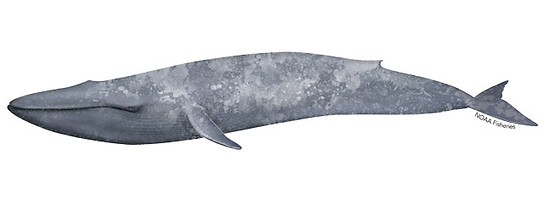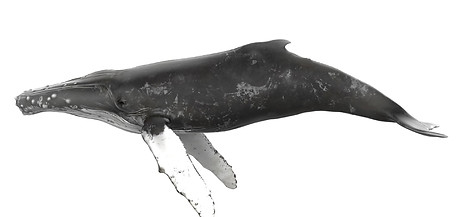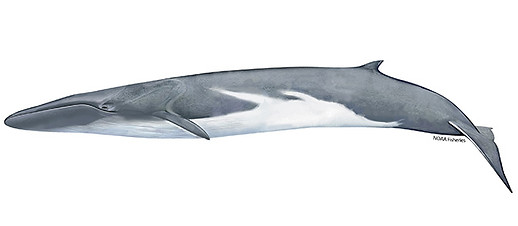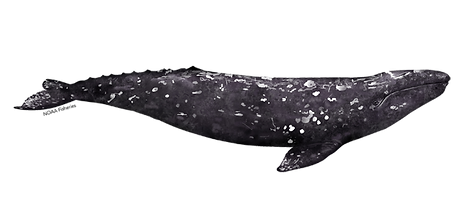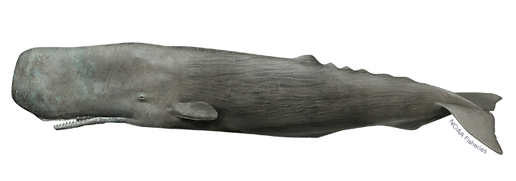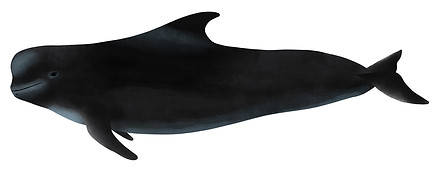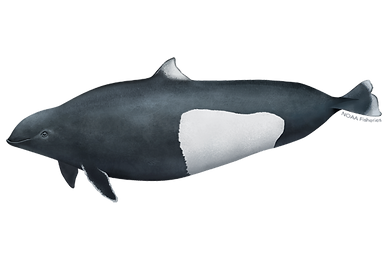



Cetaceans (from the Latin word cetus, coming from the Ancient Greek κῆτος (kêtos) 'huge fish or sea monster') are an infraorder of aquatic mammals belonging to the order Artiodactyla that includes whales, dolphins, and porpoises. Key characteristics of its species is the full adaptation to an aquatic life cycle, a streamlined body shape, often a large size and exclusively a carnivorous diet. They propel themselves through the water with powerful up-and-down movement of their tail which ends in a paddle-like fluke, using their flipper-shaped forelimbs to maneuver.
Cetaceans are grouped into two taxonomic suborders: the baleen whales (Mysticeti) and the toothed whales (Odontoceti). Mysticetes are filter feeders that forage for zooplankton and small fish by skimming or gulping huge amounts of prey and water. The water is then forced back out the mouth past hundreds of baleen plates that act as sieves to trap the prey, which is then swallowed. Odontocetes have various numbers of identical conical or spade-shaped teeth that are used to strain or grasp prey, primarily fish and squid. Odontoceti are generally capable of echolocation. They can discern the size, shape, surface characteristics, distance and movement of an object. They can search for, chase and catch fast-swimming prey in total darkness.
BLUE WHALE (Balaenoptera musculus)
Blue whales are the largest animals ever to live on our planet. They feed almost exclusively on krill, straining huge volumes of ocean water through their baleen plates (which hang from the roof of the mouth and work like a sieve). Some of the biggest individuals may eat up to 6 tons of krill a day.
https://www.fisheries.noaa.gov/species/blue-whale
HUMPBACK WHALE (Megaptera novaeangliae)
Humpback whales live in all oceans around the world. They travel great distances every year and have one of the longest migrations of any mammal on the planet. Some populations swim 5,000 miles from tropical breeding grounds to colder, more productive feeding grounds.
https://www.fisheries.noaa.gov/species/humpback-whale
FIN WHALE (Balaenoptera physalus)
The fin whale is the second-largest whale species on earth, second only to the blue whale. It is found throughout the world’s oceans. Like all large whales, fin whales were hunted by commercial whalers, which severely lowered their populations. Whalers did not target them at first, because they were fast swimmers and lived in open ocean habitats.
https://www.fisheries.noaa.gov/species/fin-whale
GRAY WHALE (Eschericus robustus)
Once common throughout the Northern Hemisphere, gray whales are now only regularly found in the North Pacific Ocean where there are two extant populations, one in the eastern and one in the western North Pacific.
Among baleen whales, the Gray whale is the only one bottom feeding using his baleen to filter mud from the bottom of the Oceans in areas such as the ones of the Santa Barbara Channel.
https://www.fisheries.noaa.gov/species/gray-whale
MINKIE WHALE (Balaenoptera acutorostrata)
Minke whales are members of the baleen or “great” whale family and are the smallest of the rorquals. They are one of the most abundant rorqual in the world, and their population status is considered stable throughout almost their entire range (especially when compared to other species of large whales).It is said that this species received its common name from a Norwegian novice whaling spotter named Meincke, who supposedly mistook a minke whale for a blue whale.
https://www.fisheries.noaa.gov/species/minke-whale
SPERM WHALE (Physeter macrocephalus)
Sperm whales are the largest of the toothed whales and have one of the widest global distributions of any marine mammal species. They are found in all deep oceans, from the equator to the edge of the pack ice in the Arctic and Antarctic.They are named after the waxy substance—spermaceti—found in their heads. The spermaceti is an oil sac that helps the whales focus sound. Spermaceti was used in oil lamps, lubricants, and candles.
https://www.fisheries.noaa.gov/species/sperm-whale
KILLER WHALE (Orcinus orca)
The killer whale, also known as orca, is the ocean’s top predator. It is the largest member of the Delphinidae family, or dolphins. Found in every ocean in the world, they are the most widely distributed of all cetaceans (whales and dolphins).Taken as a whole, the species has the most varied diet of all cetaceans, but different populations are usually specialized in their foraging behavior and diet. They often use a coordinated hunting strategy, working as a team like a pack of wolves.
https://www.fisheries.noaa.gov/species/killer-whale
FALSE KILLER WHALE (Pseudorca crassidens)
False killer whales are social animals found globally in all tropical and subtropical oceans and generally in deep offshore waters. The false killer whale’s entire body is black or dark gray, although lighter areas may occur ventrally (on its underside) between the flippers or on the sides of the head.False killer whales are known to depredate (take fish and bait off of fishing lines), which can lead to hooking and/or entanglement especially for the Hawaiian population where longlines fishery is very common.
https://www.fisheries.noaa.gov/species/false-killer-whale
RISSO'S DOLPHIN (Grampus griseus)
Risso's dolphins, sometimes called gray dolphins, are found in the temperate and tropical zones of all the world’s oceans. These cetaceans generally prefer deeper offshore waters, especially near the continental shelf edge and slope, where they can dive to at least 1,000 feet and hold their breath for 30 minutes. They are also very active on the ocean surface.Risso's dolphins are typically found in groups of between 10 and 30 animals, though they have been reported as solitary individuals, in pairs, or in loose aggregations in the hundreds or thousands. Occasionally, this species associates with other dolphins and whales.
https://www.fisheries.noaa.gov/species/rissos-dolphin
SHORTH FINNED PILOT WHALE (Globicephala macrorhynchus)
Found globally in tropical and temperate oceans, Short-finned pilot whales are long-lived, slow to reproduce, and highly social. They live in stable groups of 15 to 30 animals composed of close family relatives, and tend to live in localized, resident populations, although some populations have wider ranges. Their diet consists primarily of squid, with a small amount of fish. They are commonly encounter along the coast close to the continental shelf, although some populations have been found to extend into deep, open ocean environments such as in the eastern tropical Pacific Ocean.
https://www.fisheries.noaa.gov/species/short-finned-pilot-whale
BOTTLENOSE DOLPHIN (Tursiops truncatus)
Common bottlenose dolphins (referred to hereafter simply as bottlenose dolphins) are found throughout the world in both offshore and coastal waters, including harbors, bays, gulfs, and estuaries of temperate and tropical waters (estuaries are the areas where rivers meet the sea). They are one of the most well-studied marine mammals in the wild. In addition, they are easy to view in the wild because they live close to shore and are distributed throughout coastal and estuarine waters. But this puts bottlenose dolphins at increased risk of human-related injuries and death. They are a highly intelligent species and use sound both for communication and to hunt for food.
https://www.fisheries.noaa.gov/species/common-bottlenose-dolphin
SHORTH BEAKED COMMON DOLPHIN (Delphinus delphis)
Short-beaked common dolphins are one of the most abundant and familiar dolphins in the world. This highly social and energetic species is widely distributed, preferring warm tropical to cool temperate waters that are primarily offshore. Short-beaked common dolphins are often found in association with underwater ridges, seamounts, and continental shelves where upwelling (a process in which deep, cold, nutrient-rich water rises toward the surface) occurs and prey is abundant.
https://www.fisheries.noaa.gov/species/short-beaked-common-dolphin
LONG BEAKED COMMON DOLPHIN (Delphinus capensis)
Long-beaked common dolphins can be found in large social groups in the Atlantic, Indian, and Pacific Oceans. This highly social and energetic species prefers shallow, tropical, subtropical, and warmer temperate waters closer to the coast and on the continental shelf.Long-beaked common dolphins are closely related to—and easily confused with—short-beaked common dolphins. Once thought to be a single species, the two species differ slightly in size, appearance and habitat preference. Long-beaked common dolphins are less abundant than their short-beaked relatives.
https://www.fisheries.noaa.gov/species/long-beaked-common-dolphin
STRIPED DOLPHIN (Stenella coeruleoalba)
Striped dolphins are among the most abundant and widespread dolphins in the world. They prefer deep tropical to warm temperate oceanic waters, and are attracted to upwelling areas, where deep, cold, nutrient-rich water rises toward the surface, and convergence zones, where ocean currents meet.Usually found in tight, cohesive groups of about 25 to 100 individuals, they have been observed breaching, jumping, and leaping over 20 feet above the surface of the water. They display a unique behavior called roto-tailing, when the animal leaps high out of the water and vigorously rotates its tail while airborne.
https://www.fisheries.noaa.gov/species/striped-dolphin
PACIFIC WITHE SIDED DOLPHIN (Lagenorhynchus obliquidens)
Pacific white-sided dolphins, known for the distinct coloring that give them their name, are a playful and highly social marine mammal. They are also sometimes known as the “hookfin porpoise” because of their large, curved dorsal fin, though they are not technically porpoises.In the United States, Pacific white-sided dolphins live off the coasts of California, Oregon, Washington, and Alaska. They can be seen traveling in schools of thousands, but group sizes are usually between 10 and 100 animals. These extremely playful dolphins are often seen “bow riding” (swimming near the front part of a ship) and jumping, somersaulting, or even spinning in the air.
https://www.fisheries.noaa.gov/species/pacific-white-sided-dolphin
DALL'S PORPOISE (Phocoenoides dalli)
Dall's porpoises are common in the North Pacific Ocean and can be found off the U.S. West Coast from California to the Bering Sea in Alaska. These porpoises are considered the fastest swimmers among small cetaceans, reaching speeds of 34 miles per hour over short distances. They are named for W.H. Dall, an American naturalist who collected the first specimen of this species.A special characteristic of Dall’s porpoises is their distinctive color pattern: a black body with a conspicuous white lateral patch on the left, right, and underside. They are often mistaken for baby killer whales, but unlike killer whales, their dorsal fins are triangle-shaped and they do not have eye patches or saddle patches.
https://www.fisheries.noaa.gov/species/dalls-porpoise
HARBOR PORPOISE (Phocena phocena)
The harbor porpoise is a shy animal, most often seen in groups of two or three. They prefer coastal areas and are most commonly found in bays, estuaries, harbors, and fjords. Because they prefer coastal habitats, harbor porpoises are particularly vulnerable to gillnets and fishing traps, pollution, and other types of human disturbance, such as underwater noise.
https://www.fisheries.noaa.gov/species/harbor-porpoise
NORTHEN RIGHT WHALE DOOLPHIN (Lissodelphis borealis)
Northern right whale dolphins are found in the deep, cold to warm temperate waters of the Pacific Ocean. They usually travel in groups of 100 to 200 individuals but sometimes travel in groups of up to 3,000. They are “acrobatic” swimmers and can leap more than 20 feet over the surface of the water.
Northern right whale dolphins are the only species of dolphin in the North Pacific Ocean without a dorsal fin. At sea, they are sometimes mistaken for herds of fur seals and sea lions due to their dark, streamlined body.
https://www.fisheries.noaa.gov/species/northern-right-whale-dolphin

